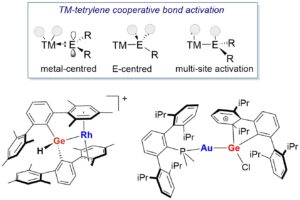 In contrast to previous beliefs, the reactivity of heavier low-valent main group (MG) elements resembles more that of transition metals (TMs) than of their lighter counterparts, as exemplified by oxidative addition reactions mediated by low-valent MG centers. However, oxidative addition processes generate thermodynamically stable products that often prevent catalytic turnover by redox processes. As part of our interest in exploiting bimetallic cooperation, we started to explore the chemistry of mixed transition/main group metal complexes by combining sterically hindered organometallic species with highly reactive low-valent centers, mostly with tetrylenes (group 14 divalent species). Our aim is to develop cooperative routes towards the activation of small molecules and, eventually, to design catalytic cycles based on MG/TM systems.
In contrast to previous beliefs, the reactivity of heavier low-valent main group (MG) elements resembles more that of transition metals (TMs) than of their lighter counterparts, as exemplified by oxidative addition reactions mediated by low-valent MG centers. However, oxidative addition processes generate thermodynamically stable products that often prevent catalytic turnover by redox processes. As part of our interest in exploiting bimetallic cooperation, we started to explore the chemistry of mixed transition/main group metal complexes by combining sterically hindered organometallic species with highly reactive low-valent centers, mostly with tetrylenes (group 14 divalent species). Our aim is to develop cooperative routes towards the activation of small molecules and, eventually, to design catalytic cycles based on MG/TM systems.
For some recent work, see for instance:
- Bajo, S.; Alférez, M. G.; Alcaide, M. M.; López-Serrano, J.; Campos, J.* Metal‐Only Lewis Pairs of Rhodium with s, p and d‐Block Metals, Chem. Eur. J. 2020, 26, 16833. (Invited contribution to the Young Chemists Special Issue).
- Bajo, S.; Alcaide, M. M.; López-Serrano, J.; Campos, J.* Structural Snapshots of π‐arene Bonding in a Gold Germylene Cation, Chem. Eur. J. 2020, 26, 15519. [Special Issue: 1000th Issue]
- Bajo, S.; Alcaide, M. M.; López-Serrano, J.; Campos, J.* Dehydrogenative Double C-H Bond Activation in a Germylene-Rhodium Complex, Chem. Eur. J. 2021, 27, 16422.
- Somerville, R.J.; Campos, J.* Cooperativity in Transition Metal Tetrylene Complexes, Eur. J. Inorg. Chem. 2021, 3488. [Minireview] (Invited contribution to the RSEQ-GEQO Prize Winners)
- Bajo, S.; Theulier, C. A.; Campos, J.* Mechanistic Investigations on Hydrogenation, Isomerization and Hydrosilylation Reactions Mediated by a Germyl-Rhodium System, ChemCatChem 2022, e202200157.
